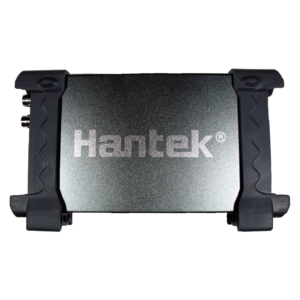Difference between revisions of "Hantek 6022BE"
Uwe Hermann (talk | contribs) |
Uwe Hermann (talk | contribs) (Hantek 6022BE is now supported. Update protocol docs.) |
||
| Line 1: | Line 1: | ||
[[File:Hantek 6022be. | [[File:Hantek 6022be mugshot.png|thumb|right|Hantek 6022BE]] | ||
The [http://www.hantek.com/en/ProductDetail_2_31.html Hantek 6022BE] is a USB-based, 2-channel oscilloscope with an analog bandwidth of 20MS/s and 48MS/s sampling rate. | The [http://www.hantek.com/en/ProductDetail_2_31.html Hantek 6022BE] is a USB-based, 2-channel oscilloscope with an analog bandwidth of 20MS/s and 48MS/s sampling rate. | ||
| Line 42: | Line 42: | ||
== Protocol == | == Protocol == | ||
{| border="0" style="font-size: smaller" class="alternategrey sortable sigroktable" | |||
|- | |||
!Oscilloscope command | |||
!bRequest value | |||
{| class=" | !Notes | ||
! | |||
! | |||
! | |||
|- | |- | ||
|Set CH0 voltage range ||0xE0 ||Possible values: 1,2,5,10 (5V, 2.5V, 1V, 500mV). | |Set CH0 voltage range ||0xE0 ||Possible values: 1,2,5,10 (5V, 2.5V, 1V, 500mV). | ||
| Line 55: | Line 52: | ||
|Set CH1 voltage range ||0xE1 ||Possible values: 1,2,5,10 (5V, 2.5V, 1V, 500mV). | |Set CH1 voltage range ||0xE1 ||Possible values: 1,2,5,10 (5V, 2.5V, 1V, 500mV). | ||
|- | |- | ||
|Set | |Set sampling rate ||0xE2 ||Possible values: 48, 30, 24, 16, 8, 4, 1 (MHz) and 50,20,10 (*10kHz). | ||
|- | |- | ||
| | |Trigger oscilloscope ||0xE3 ||Possible values: 1 == start sampling. | ||
|- | |- | ||
| | |Set number of channels ||0xE4 ||Possible values: 1, 2. | ||
|- | |- | ||
|} | |} | ||
== Firmware == | |||
We use the open-source firmware file '''hantek-6022be.fw''' from [[fx2lafw|sigrok-firmware-fx2lafw]] for this device. The firmware was originally written by Jochen Hoenicke (see [http://sigrok.org/gitweb/?p=sigrok-firmware-fx2lafw.git;a=blob;f=README README] for details), thanks a lot! | |||
The protocol of the open-source firmware we use (see [[Hantek_6022BE#Firmware|below]]) is similar, but not identical, to the vendor's firmware protocol. The vendor firmware was originally reverse engineered and documented for the [https://github.com/rpcope1/Hantek6022API/blob/master/REVERSE_ENGINEERING.md Hantek6022API] project. The open-source '''implementation''' was done from scratch, though. | |||
The firmware | '''Note''': The firmware is '''not''' flashed into the device permanently! You need to only make it available in the usual place where [[libsigrok]] looks for firmware files, it will be used automatically (and "uploaded" to the Cypress FX2's SRAM every time you attach the 6022BE to a USB port). | ||
== Resources == | == Resources == | ||
| Line 80: | Line 75: | ||
[[Category:Device]] | [[Category:Device]] | ||
[[Category:Oscilloscope]] | [[Category:Oscilloscope]] | ||
[[Category: | [[Category:Supported]] | ||
Revision as of 01:07, 14 March 2016
The Hantek 6022BE is a USB-based, 2-channel oscilloscope with an analog bandwidth of 20MS/s and 48MS/s sampling rate.
See Hantek_6022BE/Info for more details (such as lsusb -v output) about the device.
Hardware
- Main chip + USB: FX2LP
- Main oscillator: unknown
Photos
Another teardown:
Protocol
| Oscilloscope command | bRequest value | Notes |
|---|---|---|
| Set CH0 voltage range | 0xE0 | Possible values: 1,2,5,10 (5V, 2.5V, 1V, 500mV). |
| Set CH1 voltage range | 0xE1 | Possible values: 1,2,5,10 (5V, 2.5V, 1V, 500mV). |
| Set sampling rate | 0xE2 | Possible values: 48, 30, 24, 16, 8, 4, 1 (MHz) and 50,20,10 (*10kHz). |
| Trigger oscilloscope | 0xE3 | Possible values: 1 == start sampling. |
| Set number of channels | 0xE4 | Possible values: 1, 2. |
Firmware
We use the open-source firmware file hantek-6022be.fw from sigrok-firmware-fx2lafw for this device. The firmware was originally written by Jochen Hoenicke (see README for details), thanks a lot!
The protocol of the open-source firmware we use (see below) is similar, but not identical, to the vendor's firmware protocol. The vendor firmware was originally reverse engineered and documented for the Hantek6022API project. The open-source implementation was done from scratch, though.
Note: The firmware is not flashed into the device permanently! You need to only make it available in the usual place where libsigrok looks for firmware files, it will be used automatically (and "uploaded" to the Cypress FX2's SRAM every time you attach the 6022BE to a USB port).




















